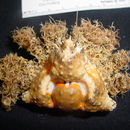en
names in breadcrumbs


Rhinolithodes wosnessenskii, also called the rhinoceros crab or golf-ball crab,[2] is a species of king crab, the only species in the genus Rhinolithodes. The species is named after Ilya Gavrilovich Voznesenski.[3] It is found at depths of 6–73 metres (20–240 ft) in the north-east Pacific Ocean from Kodiak, Alaska to Crescent City, California.[4][5]
R. wosnessenskii grows to 7 centimetres (2.8 in) across the carapace, which is triangular and has a deep semicircular depression. The legs are covered in spines and long setae. It lives in crevices on rocky or gravel bottoms, and is only rarely encountered.[5]
Rhinolithodes wosnessenskii, also called the rhinoceros crab or golf-ball crab, is a species of king crab, the only species in the genus Rhinolithodes. The species is named after Ilya Gavrilovich Voznesenski. It is found at depths of 6–73 metres (20–240 ft) in the north-east Pacific Ocean from Kodiak, Alaska to Crescent City, California.
R. wosnessenskii grows to 7 centimetres (2.8 in) across the carapace, which is triangular and has a deep semicircular depression. The legs are covered in spines and long setae. It lives in crevices on rocky or gravel bottoms, and is only rarely encountered.